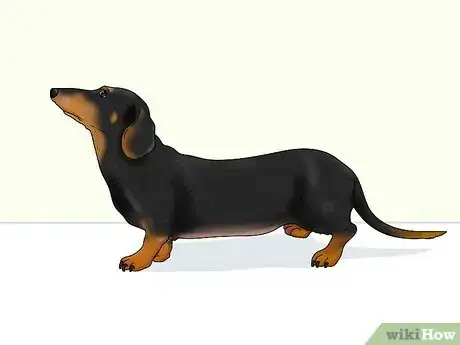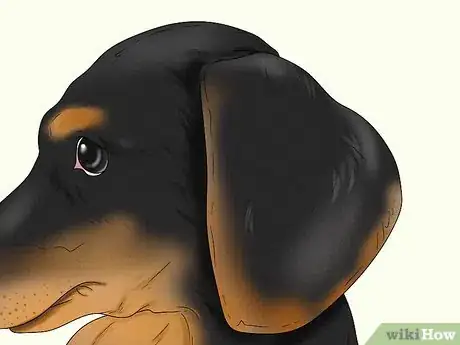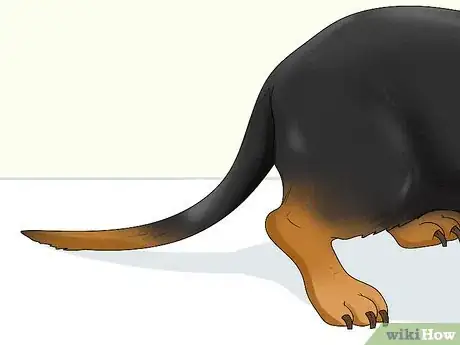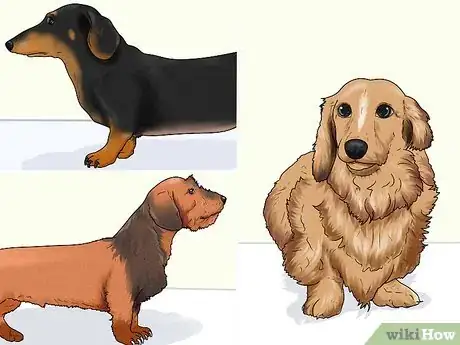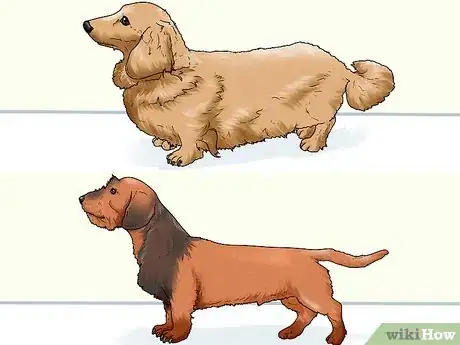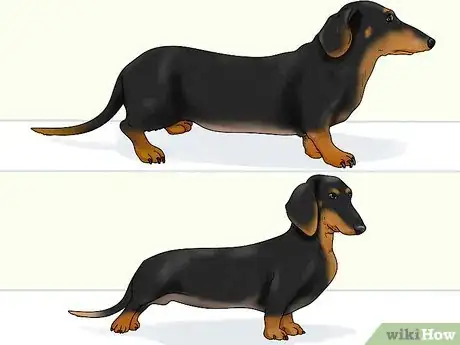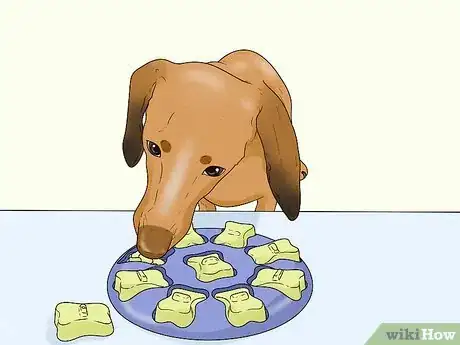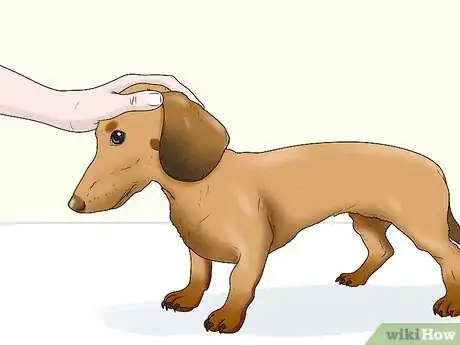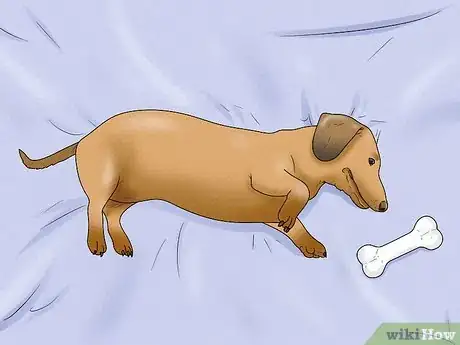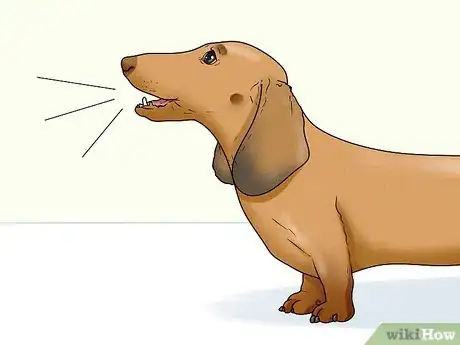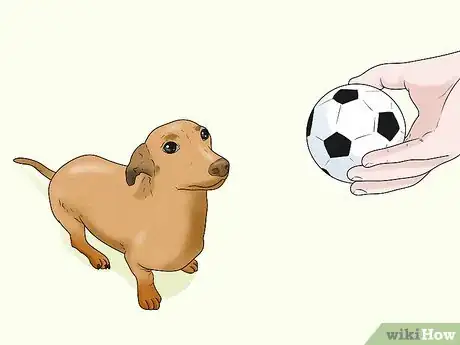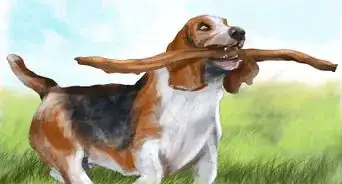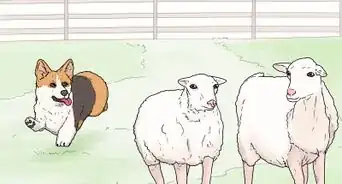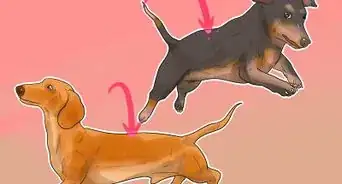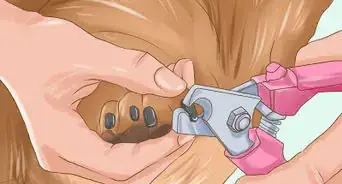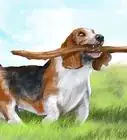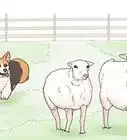X
wikiHow is a “wiki,” similar to Wikipedia, which means that many of our articles are co-written by multiple authors. To create this article, volunteer authors worked to edit and improve it over time.
This article has been viewed 9,911 times.
Learn more...
The Dachshund is a popular breed, well-known for its short, long body resembling a hotdog. Seen in two sizes and with three coat types,[1] they can vary in appearance greatly. With their friendly personalities, Dachshunds can make great pets. This wikiHow will help you determine if a dog is a Dachshund.
Steps
Method 1
Method 1 of 3:
Noticing Body Structure
-
1Look at the dog's size. Dachshunds come in two sizes: standard and miniature. Standard Dachshunds are 8–9 inches (20–23 cm) in height and 16–32 pounds (7.3–14.5 kg) in weight, while miniature Dachshunds are typically 5–6 inches (13–15 cm) tall and weigh 11 pounds (5.0 kg) or less.[2]
- Some people also consider Dachshunds under 8 pounds (3.6 kg) to be their own size, referred to as "rabbit Dachshunds", though the AKC does not yet recognize this as a separate Dachshund size.[3]
-
2Notice the ears. Dachshunds have moderately long, round ears.[4] They are set near the top of the head and hang down. A Dachshund's ears may bounce slightly as the dog runs.Advertisement
-
3Check the eyes. Dachshunds have medium-sized, almond-shaped eyes. Look for dark eyes that give the dog a pleasant and energetic expression.[5]
-
4Look at the tail. The tail of a Dachshund is slim. It is described as being "set in continuation of the spine".[6]
-
5Inspect the overall structure. Dachshunds have a recognizable structure: their bodies are long and low-set, with short legs. They are fairly muscular and have a smooth gait.[7]
Advertisement
Method 2
Method 2 of 3:
Looking at the Coat
-
1Differentiate between coat types. Dachshunds can be seen sporting three different types of coats: smooth, wirehaired, or longhaired.
-
2Identify the coat color. Dachshunds have a wide range of acceptable colors, from one solid color to two colors. Common solid coat colors are red and cream, and colors frequently seen on a two-colored coat are black, chocolate, wild boar, grey/blue, and fawn, with tan or cream markings on the face, throat, chest, legs/paws, and tail.[11] A white spot on the chest may also be seen.
-
3Check the coat pattern. Though not all Dachshunds have patterns and are just seen with solid coats, coat patterns such as merle and brindle are common in Dachshunds.
- Dapple/Merle coats are coats with spots of a lighter shade on a dark base color.[12]
- Brindle coats appear as coats striped with a darker color.[13]
- Piebald coats are one- or two-colored coats with white patches or areas.[14]
- Sable coats are coats which have a dark overlay over a solid red coloring.[15]
Advertisement
Method 3
Method 3 of 3:
Watching the Temperament
-
1
-
2Watch for loyalty. Due to their independence, Dachshunds may take a while to understand who's in charge. However, once they do, they can become loyal, devoted pets.[18]
-
3See if the dog is stubborn. Dachshunds exhibit stubbornness alongside their independence. They may be hesitant to follow directions, even if they are told to do something they want to do.[19]
-
4Expect barking. Bred to hunt, a Dachshund may be full of energy, causing it to bark at many things. Anticipate barking and a desire to run around from a Dachshund.[20]
Did you know? As badger hunters, Dachshunds worked primarily underground. Their loud bark helped inform their human partner of their location.[21]
-
5Check for liveliness. Dachshunds are a playful, lively breed. See if the dog enjoys playing or making games out of simple activities.[22]
Advertisement
Community Q&A
-
QuestionCan I feed vegetables to my Dachshund?
 LinnieTop AnswererYes. Some vegetables that are safe for dogs to eat in small amounts include cabbage, Brussels sprouts, spinach, carrots, green beans, broccoli, and corn. However, never feed your Dachshund onions, chives, leeks, or mushrooms as these can be toxic.
LinnieTop AnswererYes. Some vegetables that are safe for dogs to eat in small amounts include cabbage, Brussels sprouts, spinach, carrots, green beans, broccoli, and corn. However, never feed your Dachshund onions, chives, leeks, or mushrooms as these can be toxic.
Advertisement
References
- ↑ https://www.akc.org/dog-breeds/dachshund/
- ↑ https://www.akc.org/dog-breeds/dachshund/
- ↑ https://www.dogtemperament.com/rabbit-dachshund-temperament/
- ↑ http://images.akc.org/pdf/breeds/standards/Official_Standard_Dachshund.pdf
- ↑ http://images.akc.org/pdf/breeds/standards/Official_Standard_Dachshund.pdf
- ↑ http://images.akc.org/pdf/breeds/standards/Official_Standard_Dachshund.pdf
- ↑ http://images.akc.org/pdf/breeds/standards/Official_Standard_Dachshund.pdf
- ↑ http://images.akc.org/pdf/breeds/standards/Official_Standard_Dachshund.pdf
- ↑ http://images.akc.org/pdf/breeds/standards/Official_Standard_Dachshund.pdf
- ↑ http://images.akc.org/pdf/breeds/standards/Official_Standard_Dachshund.pdf
- ↑ http://images.akc.org/pdf/breeds/standards/Official_Standard_Dachshund.pdf
- ↑ http://images.akc.org/pdf/breeds/standards/Official_Standard_Dachshund.pdf
- ↑ http://images.akc.org/pdf/breeds/standards/Official_Standard_Dachshund.pdf
- ↑ http://images.akc.org/pdf/breeds/standards/Official_Standard_Dachshund.pdf
- ↑ http://images.akc.org/pdf/breeds/standards/Official_Standard_Dachshund.pdf
- ↑ https://www.akc.org/dog-breeds/dachshund/
- ↑ https://www.dogtemperament.com/dachshund-temperament/
- ↑ https://www.dogtemperament.com/dachshund-temperament/
- ↑ https://www.dogtemperament.com/dachshund-temperament/
- ↑ https://www.dogtemperament.com/dachshund-temperament/
- ↑ https://www.akc.org/dog-breeds/dachshund/
- ↑ https://www.dogtemperament.com/dachshund-temperament/
About This Article
Advertisement
